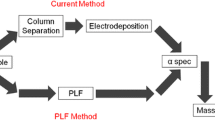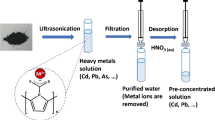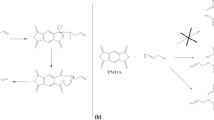Abstract
This paper describes a new analyte extraction medium called polymer ligand film (PLF) that was developed to rapidly extract radionuclides. PLF is a polymer medium with ligands incorporated in its matrix that selectively and quickly extracts analytes. The main focus of the new technique is to shorten and simplify the procedure for chemically isolating radionuclides for determination through alpha spectroscopy. The PLF system was effective for plutonium and uranium extraction. The PLF was capable of co-extracting or selectively extracting plutonium over uranium depending on the PLF composition. The PLF and electrodeposited samples had similar alpha spectra resolutions.







Similar content being viewed by others
References
Helfand I, Forrow L, Tiwari J (2002) Nuclear terrorism. BMJ 324:356–359
Grant PM, Moody KJ, Hutcheon ID et al (1998) Nuclear forensics in law enforcement applications. J Radioanal Nucl Chem 235:129–132. doi:10.1007/BF02385950
Mayer K, Wallenius M, Fanghänel T (2007) Nuclear forensic science—from cradle to maturity. J Alloys Compd 444–445:50–56. doi:10.1016/j.jallcom.2007.01.164
Mayer K, Wallenius M, Ray I (2005) Nuclear forensics—a methodology providing clues on the origin of illicitly trafficked nuclear materials. Analyst 130:433–441. doi:10.1039/B412922A
Press release (2014) Calculating the new global nuclear terrorism threat. http://www.iaea.org/newscenter/pressreleases/2001/nt_pressrelease.shtml. Accessed 9 Sept 2015
Baker H, Cutler L (2000) A report card on the department of energy’s nonproliferation programs with Russia. United States Department of Energy
United Nations Audiovisual Library of International Law (2014) http://legal.un.org/avl/ha/icsant/icsant.html. Accessed 9 Sept 2015
Pöllänen R, Siiskonen T (2006) High-resolution alpha spectrometry under field conditions–fast identification of alpha particle emitting radionuclides from air samples. J Environ Radioact 87:279–288. doi:10.1016/j.jenvrad.2005.12.004
Plionis AA, Rim JH, Hastings EP et al (2009) Micro-electrodeposition techniques for the preparation of small actinide counting sources for ultra-high resolution alpha spectrometry by microcalorimetry. J Radioanal Nucl Chem 282:905–908. doi:10.1007/s10967-009-0251-z
Rim JH, Gonzales ER, Armenta CE et al (2013) Developing and evaluating di(2-ethylhexyl) orthophosphoric acid (HDEHP) based polymer ligand film (PLF) for plutonium extraction. J Radioanal Nucl Chem 296:1099–1103. doi:10.1007/s10967-012-2266-0
Rim JH, Peterson DS, Armenta CE et al (2015) Evaluating ligands for use in polymer ligand film (PLF) for plutonium and uranium extraction. J Radioanal Nucl Chem. doi:10.1007/s10967-015-4118-1
Gonzáles ER, Peterson DS (2009) Rapid radiochemical sample preparation for alpha spectrometry using polymer ligand films. J Radioanal Nucl Chem 282:543–547. doi:10.1007/s10967-009-0218-0
Gonzáles ER, Klingensmith AL, Peterson DS (2011) Rapid separation and extraction of radioactive analytes onto filters and surfaces. Proc Radiochem Suppl Radiochim Acta 1:194–200. doi:10.1524/rcpr.2011.0035
Hanson SK, Mueller AH, Oldham WJ Jr (2014) Kläui ligand thin films for rapid plutonium analysis by alpha spectrometry. Anal Chem 86:1153–1159. doi:10.1021/ac402997e
Oldham WJ, Dry DE, Mueller AH (2009) Synthesis of functional monolayer surfaces for rapid radiometric determination of plutonium. J Radioanal Nucl Chem 282:585–589. doi:10.1007/s10967-009-0243-z
Koulouridakis PE, Kallithrakas-Kontos NG (2004) Selective mercury determination after membrane complexation and total reflection X-ray fluorescence analysis. Anal Chem 76:4315–4319. doi:10.1021/ac049780a
Surbeck H (2000) Alpha spectrometry sample preparation using selectively adsorbing thin films. Appl Radiat Isot 53:97–100
Graul TW, Li M, Schlenoff JB (1999) Ion exchange in ultrathin films. J Phys Chem B 103:2718–2723. doi:10.1021/jp983049o
Wang L, Paimin R, Cattrall RW et al (2000) The extraction of cadmium(II) and copper(II) from hydrochloric acid solutions using an Aliquat 336/PVC membrane. J Membr Sci 176:105–111. doi:10.1016/S0376-7388(00)00436-1
Horwitz EP, Chiarizia R, Dietz ML (1997) DIPEX: a new extraction chromatographic material for the separation and preconcentration of actinides from aqueous solution. React Funct Polym 33:25–36. doi:10.1016/S1381-5148(97)00013-8
Moyer BA (2009) Ion exchange and solvent extraction: a series of advances, vol 19. Taylor and Francis, Hoboken
Herlinger AW, Ferraro JR, Chiarizia R, Horwitz EP (1997) An investigation of P, P′-di(2-ethylhexyl) methanediphosphonic acid and some of its metal complexes. Polyhedron 16:1843–1854. doi:10.1016/S0277-5387(96)00495-0
Siemann U (2005) Solvent cast technology—a versatile tool for thin film production. Springer, Berlin, pp 1–14
Bortels G, Collaers P (1987) Analytical function for fitting peaks in alpha-particle spectra from Si detectors. Int J Rad Appl Instrum [A] 38:831–837. doi:10.1016/0883-2889(87)90180-8
Katz JJ, Morss LR, Edelstein N, Fuger J (2011) The chemistry of the actinide and transactinide elements, 4th edn. Springer, Dordrecht
Acknowledgments
This research was performed with the support of the U.S. Departments of Energy Office of Nuclear Nonproliferation Research and Development and U.S. Department of Defense’s Defense Threat Reduction Agency. The authors also gratefully acknowledge the support from the Nuclear Forensics Graduate Fellowship Program which is sponsored by the U.S. Department of Homeland Security’s Domestic Nuclear Detection Office and the U.S. Department of Defense’s Defense Threat Reduction Agency. Los Alamos National Laboratory is operated by Los Alamos National Security, LLC for the U.S. Department of Energy under contract number DE-AC52-06NA25396. This document had been reviewed and assigned publication number: ‘LA-UR-14-24118’ Version 3.
Author information
Authors and Affiliations
Corresponding author
Rights and permissions
About this article
Cite this article
Rim, J.H., Armenta, C.E., Gonzales, E.R. et al. Evaluating bis(2-ethylhexyl) methanediphosphonic acid (H2DEH[MDP]) based polymer ligand film (PLF) for plutonium and uranium extraction. J Radioanal Nucl Chem 307, 2327–2332 (2016). https://doi.org/10.1007/s10967-015-4444-3
Received:
Published:
Issue Date:
DOI: https://doi.org/10.1007/s10967-015-4444-3




